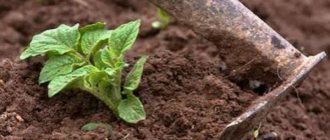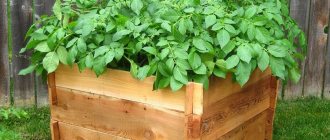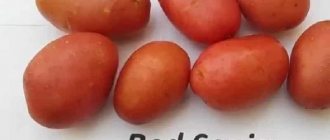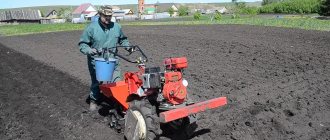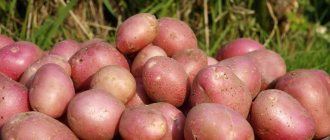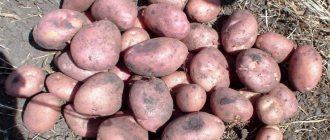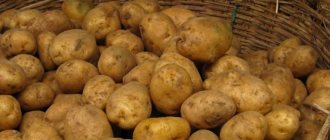Vegetable growing » Potatoes
0
1337
Article rating
Kira Stoletova
Planting potatoes with eyes is a special agrotechnical technique used by private gardeners who want to achieve large potato yields with minimal costs.
Benefits of planting potatoes with eyes
What are potatoes
Potatoes belong to the Solanaceae family of plants that have tubers. They have many beneficial substances for the human body. But the fruits of the plant should not be eaten under any circumstances, since they are poisonous due to the large amount of solanine they contain.
The name “potato” itself comes from the German Kartoffel, which was taken from the Italian word tartufolo and translated as truffle. The herbaceous part of the plant grows up to one meter in height. In this case, the stem remains bare and has edges. Part of it is immersed in the ground by 20, or even 50 centimeters.
Potato leaves are dark green in color and consist of several lobes that are placed one against the other. They are attached to a rod, which is attached to the stem using a petiole. Potato flowers form a cluster and come in shades of white, pink and purple.
In the underground part of the stem, in places intended for the formation of leaves, tubers begin to form. They ripen in September. The fruits resemble a small green tomato, no more than 2 centimeters in diameter. Thanks to solanine, the plant is protected from damage to the leaves and stem by bacteria and some pests. Solanine is also formed in greened tubers, and therefore they can no longer be eaten.
Potato propagation occurs using tubers or parts thereof. At the same time, they need to be planted to a depth of no less than 5 or 10 centimeters.
The structure of potatoes
The structure of the plant includes underground and above-ground parts. One tuber can grow from one to 6-10 stems on average due to the concentration of buds at the top of the tuber. In this case, there will definitely be the main one. The height is most often 50 cm. But there are also low-growing and very tall species. If you look at what the morphological structure of a potato stem looks like , it looks like a tetrahedral cylinder if cut across. It is believed that the smaller the vegetative mass, the better the harvest. Otherwise, the plant will spend all its energy on green mass. This result is a consequence of an excess of fertilizer.
The leaves have a complex structure: between the large leaves on the petiole there are smaller ones, called lobes and lobes. The flowers of the plant have three main colors according to variety: white, pinkish and light purple. The type of potato inflorescence is a scutellum lying on the top of the stem branch. The flower has a pistil and a stamen and is therefore considered hermaphroditic. Cross-pollination is not usually required, although such varieties are available.
The fruit of the plant is a poisonous berry, and not a tuber, as ordinary people might think. Its structure is two-leaf. Each half contains 1000 seeds, which have only breeding value. It is rare to grow potatoes from seeds, because as a perennial, they will produce tubers only after a year. This is not economically profitable. The color of the berry is similar to an unripe mini tomato with a diameter of about 2 cm.
How to plant potatoes correctly
When choosing a potato planting method, consider the following. First of all, the earth must be warmed up and freezing must stop. The timing of planting in most cases depends on climatic conditions. For example, at a time when plants are already being actively planted in the south of Ukraine, there may still be snow in Russia.
Planting potatoes the traditional way
Before planting potatoes: sprouts down or up, you need to consider the following factors. When planting tubers with their sprouts up, the potatoes quickly germinate, but at the same time they are all collected in a bunch, which is not favorable for the future harvest. First of all, early sprouted sprouts may be subject to late frosts. As a result, their growth will slow down. In addition, sprouts located very close to each other will interfere with their own growth and development. Of course, if potatoes are planted at a depth of more than 10 centimeters, then they need to be placed with their sprouts facing up.
If you place the potatoes with the sprouts down, they will make their way to the surface, bypassing the barrier, and will sprout at a distance from each other, which will contribute to their development. They sprout from the ground much later, but thanks to this, they are not afraid of the last frosts. With this planting method, you need to remember that in this case the planting depth should be from 5 to 10 centimeters, no more.
Growing potatoes from wedges (large eyes)
Root vegetables inherit the qualities of the mother tuber. This is why it is not recommended to use potatoes that are too small. Medium-sized tubers weighing 80–100 grams are considered ideal for planting. Larger potatoes are not planted for reasons of economy. But there is a way out: large tubers can be cut.
Pre-planting preparation of potatoes
Only completely healthy tubers are used for planting. The potatoes should be cut in such a way that there is an eye on each slice.
Correct cuts options
There are several options for preparing planting material:
- 35–40 days before planting, potatoes are vernalized (germinated). Immediately before planting, the sprouted potatoes are cut into pieces weighing at least 5–10 g (the size of a walnut). When starting to cut a new tuber, be sure to disinfect the knife in a strong solution of potassium permanganate. To prevent the peeled flesh from rotting, the slices are dipped in ash;
- Sprouted tubers are cut into slices 5–6 days before planting. The resulting pieces are laid out in one row in a dry, shaded place (at room temperature) so that the cut surface has time to harden before planting;
- in large tubers deposited as food, all the eyes are usually concentrated in the upper part. You can cut off about 1/3 of the potato (the one with the eyes) and use the rest for food. The damaged pulp of the part intended for planting is powdered with ash, and then for vernalization it is placed in a box and sprinkled with loose earth or sawdust. The substrate is periodically slightly moistened. When the potato pieces sprout, they are cut into slices (sometimes the eyes are located so close to each other that 2 or even 3 sprouts are left on one slice);
- tubers usually have only 4–5 active buds. To “wake up” sleeping people, they use the incision technique. The tuber is cut in the middle (crosswise) with a disinfected knife so that the halves are connected by a 1 cm thick bridge. If most of the active eyes are concentrated in one part of the tuber, step back about a centimeter from the lower eyes and make a ring cut 1 cm deep around their cluster. Then the potatoes are placed for vernalization in the same way as in the previous case, and before planting they are cut into slices.
Pieces of tubers are very vulnerable to pathogenic fungi, bacteria and insect pests. Therefore, before planting, it is advisable to spray the slices with some fungicide (for example, “Prestige”) or a solution of Bordeaux mixture.
Planting potatoes in slices
Slices are planted thicker than whole tubers. The distance between plants in a row should be 10–15 cm (for large pieces with several eyes – 20 cm), row spacing – 60–80 cm. Planting depth – no more than 6–7 cm. To save space, slices can be planted in double beds (in a checkerboard pattern). The distance between two rows in the garden bed is at least 20 cm.
A sprout emerging from a segment does not have the reserves of useful substances that are found in a whole tuber. Therefore, the groove in which the slices are to be planted is filled with compost, onion peels, ash, and eggshells. Then pieces of tubers are planted at the bottom of the groove with the sprouts facing up. Each slice is pressed a little into the ground, then the groove is filled in so that the height of the ridge above the row of potatoes is at least 10 cm.
Caring for potato bushes
After about 15–20 days, when the tops of the seedlings come close to the surface, a higher ridge is poured over them: 30 cm high, base width (for a single bed) – 60–70 cm.
Potatoes planted in this way need moisture. If the weather is dry, hot, then after the emergence of seedlings they should be watered abundantly (at the rate of 15 liters per 1 m²). The second watering should be done before budding.
Method of planting potatoes sprouts down
Before planting potatoes with sprouts down or up, they must be germinated. But the sprouts should be no more than one and a half centimeters. Otherwise, they break from the weight of the tuber. The soil for planting must be well loosened and fluffed up, as it should be very light. In addition, it is recommended to mulch the soil.
Note! If the soil in the proposed planting area turns out to be clayey, then the potato in the hole must be sprinkled with earth mixed with fine straw or sawdust.
Potatoes are planted at a distance of 35 centimeters, with a space of 90 centimeters between the rows. You can plant using the Dutch method, that is, when double rows are made. In this case, a distance of 40 centimeters is allowed between paired rows, while the gap between pairs must be no less than one meter and twenty centimeters.
In light soil, you can make holes using a flat cutter and a scoop. In addition, at the bottom of each hole you need to put a glass of humus, onion peels, crushed egg shells and a little ash. You can also use mineral fertilizers. And only after that, potatoes are placed in the hole, sprouts down, and sprinkled with the above soil mixture.
Article on the topic: Diseases of potato tubers: description, photos and treatment
Planting sprouts down
Thus, the sprouts themselves receive more moisture than with the classic planting method, and begin to actively develop, while passing the tuber and trying to get out. In addition, the part of the stem that remains underground develops much deeper into the ground, which contributes to the development of more tubers.
After the sprouts grow to twenty centimeters, the potatoes are hilled. In this case, the stems must be tilted towards the ground and mulch or the same mixture of soil and sawdust should be poured into the middle. Only five or six centimeters of stem should be left on the surface of the row. Thanks to this method, the part of the plant that remains underground becomes even larger, and the bush itself becomes wider, which is facilitated by full access of sunlight and oxygen to each individual sprout.
Thus, mulch not only helps to expand the bush, but also retains moisture at the roots of the potato bush.
Disadvantages of this method of planting potatoes
Despite the fact that planting potatoes with their eyes down has a number of advantages, especially if you look at it from a theoretical point of view, in fact, this planting method in practice has many disadvantages:
- Everyone knows that it is at the top of the tuber that a large number of eyes accumulate, and it is they that produce the strongest shoots. But in the case when planting is done with the eyes down, the plant begins to actively work to germinate them onto the soil surface. But in this case, favorable conditions are necessary for successful germination. If the weather is capricious and sends either drought or heavy rain, the sprouts may disappear and not hatch;
- A sprout planted with its tip down faces several obstacles. First of all, this is the soil. In addition to this, it is necessary to overcome such an obstacle as one’s own roots. In addition, the so-called dormant buds begin to develop and sprout on the tuber. They also need to be avoided. For this reason, for planting it is necessary to select planting material weighing at least 80 grams;
- The young tops of the sprouts hatch much later than those planted in the classical way. Thus, they become an excellent treat for Colorado potato beetles, since the tops of an adult plant become hard and tough;
- If you plant potatoes in this way in regions with a hot climate, the resulting young tubers will develop and grow poorly;
- If the mulch is close to the tuber, it can infect it with diseases.
Sprouts should be no more than one and a half centimeters
Archive number No. 17 (1071) dated April 21, 2015 - Household chores
TO YOUR EXPERIENCE
Unfortunately, some owners have a more than prosaic attitude towards potatoes: they planted them, hilled them. And it’s good if you reaped at least some harvest. How to avoid mistakes and losses? This is what our conversation is about today with Candidate of Agricultural Sciences Ivan Ivanovich Kolyadko.
Conditions for a large harvest
Potatoes don't seem to need much introduction. And in vain. For us, this is a familiar annual plant, but it is a perennial crop.
Let's start with the fact that a potato tuber is not part of the root at all, but a thickened underground part of the stem, which contains a supply of nutrients. On the surface of the tuber there are growth points - eyes. When potatoes sprout, long, thin stems (stolons) grow underground, just like shoots with leaves in the above-ground part of the plant.
From one planted tuber, 4–8 stems grow (depending on the number of awakened eyes), on which new tubers will subsequently form.
[td]
Despite the fact that potatoes are grown almost all over the world, our conditions are most favorable for them. The soil and climatic zones of the Kursk region almost perfectly correspond to its biological characteristics. But at the same time, for the maximum manifestation of its potential, it is necessary to create certain conditions.
The soil.
Potatoes have a poorly developed root system (the roots go deep only 20–30 cm), and therefore the vegetable is very demanding on the soil. It should be light and loose. Sandy loam and medium loamy soils with a topsoil density of 1.1 to 1.3 g/cubic meter are considered the best for potatoes. cm. When soil compaction is up to 1.4 g/cubic. cm, the yield is reduced to 50%, and at a density of 1.6 g/cu. cm tubers completely rot and do not sprout. Sandy, sandy and peat-boggy soils are not suitable for growing “second bread”.
Potatoes are also extremely demanding of soil air conditions. Therefore, it is so important to constantly and evenly loosen the plantings throughout almost the entire growing season. By the way, this will also help preserve moisture: when the soil crust is destroyed, evaporation decreases by 5–6 times.
Landing location
. Many villagers grow potatoes in the garden, under the crowns of apple and pear trees, in the shade of buildings, next to bushes... And wrong! In the bulb, like any light-loving plant, when there is a lack of light, the stems become elongated, their development slows down, and the seedlings, covered by weeds, turn yellow and die.
Watering.
While watering the garden, many people forget about the potato beds. And they make an unforgivable mistake. During the growing season, water consumption per 1 hectare should be from 30 to 40 cubic meters. m. Moisture is especially important when young nodules are formed - during the period from budding to flowering. If there is no moisture, do not expect a good harvest. This time. Secondly, if the weather is dry and hot, then scab develops on the tubers. And one of the ways to combat this disease is watering.
But after flowering, watering can be reduced. Due to an excess of moisture and, accordingly, a lack of oxygen, it is during this period that the tubers suffocate and rot. And as confirmation of this is the appearance of loose white lentils on the tubers.
Nutrition. As for nutrition, in the conditions of our soil and climatic zones, plants most of all need nitrogen, phosphorus and potassium. Subject to the requirements of agricultural technology, 4–6 kg of nitrogen, 1.5–2 kg of phosphorus and 7–9 kg of potassium are added from the soil per ton of tubers and 800 kg of tops. That is why organic matter is so valuable for potatoes - manure, composts, humus, etc. During the emergence of seedlings, nitrogen is important for the plant, during flowering - phosphorus, and during the period of harvesting - potassium.
For potatoes to grow, light, heat, and moisture are equally important. And replacing one with another is unacceptable. No matter how hard you try to fertilize the soil, if there is little moisture in it, it is too compacted, or the temperature conditions during planting are not maintained, you will not get a high yield.
Potato secrets
— What should you pay attention to first when landing?
— Since planting dates are already delayed by 10–14 days, special attention is paid to preparing both the seeds and the soil itself for sowing. Today, no one can say one hundred percent what summer will be like - hot or cold, dry or wet. That is why it is so important to retain as much moisture as possible when cultivating the soil in spring, so that April morning frosts and cold winds do not dry it out. As soon as the soil dries out a little, immediately loosen it to a depth of 5–7 cm with a harrow or cultivator. Plow plowing begins when the soil is ripe for cultivation: it will crumble easily in the palm of your hand. The depth of plowing (or digging) should be 3–4 cm less than autumn tillage, but not less than 16 cm.
— May cold snaps (even down to minus 1 degree within half an hour) are destructive for potatoes. What should I do?
- If the potatoes have not sprouted and are lying in the ground, then they are not afraid of sub-zero temperatures. But the sprouts that have already appeared must be covered with something. You can sprinkle it with earth, plant it, cover it with spunbond or polyethylene (the main thing is that the film does not touch the plants). After warm weather sets in, open the plantings. After a few days, the slightly crushed tops will rise. If you didn’t have time to cover it and the tops froze, then don’t be upset. This does not mean at all that the entire crop was lost - potatoes have a very high regenerative, that is, restoration, ability. You just need to feed it with nitrogen in time.
— When choosing a variety, many of us focus on the starchiness of the potato. Is it possible to determine it yourself?
- Yes, for this it is enough to conduct a small test experiment. Choose the tuber you like, cut it into two parts, rub them together, and then put them together. The potato halves, rich in starch, will stick together like magnets. Take one of them by the top and lift it up. If your potatoes don't fall apart in two, it means they have enough starch!
We breed the variety we like
Due to the fact that potatoes are affected by viruses, it is necessary to change the variety every 3-4 years. Many private owners plant the same variety for decades, and then also select the smallest tubers for seeds, which (if this is not a special seed plot) usually come from diseased bushes. All this certainly affects the harvest. After all, potatoes, like no other agricultural crop, are affected by viral, fungal and bacterial diseases, which are easily transmitted through tubers to the next generation. That is why timely (once every 3-4 years) variety renewal (new seeds of the same variety), and even better, variety seeds (high-quality seeds of new varieties), are so important for him.
To breed the variety you like, as scientific experience shows, even one tuber is enough.
There are several breeding options.
The first is with the eyes.
To do this, you need to germinate the tuber in advance, then divide it into parts so that each has 1-2 eyes. Such small divisions should be planted only in well-warmed soil.
The second method is cuttings from sprouts.
To do this, carefully break out 1–2 cm sprouts at the base of the tuber and plant them in loose soil. From one eye we can get 2-3 sprouts-cuttings, and from one potato - up to 20 sprouts in three harvests.
We should not forget that potatoes, like tomatoes, belong to the nightshade family, and therefore can be propagated by stepsons. In early June, as soon as the tops reach 30–40 cm, cut 1–2 cuttings 20–25 cm long from the bush, clear them of leaves and plant them on well-loosened, fertilized and abundantly watered soil, leaving 5–8 cm on the surface During the week, water every other day, and as soon as the plants begin to grow, do not forget to hill up in a timely manner.
Preparing for landing
Potatoes must be properly prepared for planting. Vernalization begins 20–60 days before planting. It is best to germinate tubers that have not yet hatched. For the first 10–12 days, maintain the temperature within 18–20 degrees Celsius. This is the so-called temperature shock. In the next two weeks – +10–14. If at the beginning of germination the temperature is low, then not all the eyes will “wake up”, but only those in the upper part of the tuber. As a result, the harvest will be significantly smaller.
Don't want to sprout tubers?
Then warm them at room temperature (+17–20 degrees) for 3–5 days. Or let it dry for 10 days before planting in a shed, under a shed, or just outdoors.
You can increase the number of “awakened” eyes with a special, stimulating incision. Make a deep centimeter circular cut in the middle of the tuber. Then, as usual, germinate the potatoes for a month in the light.
By the way, techniques that accelerate germination can be combined. Especially when it comes to early varieties. First, expose the tubers to light for 20–25 days, and then cover them with damp peat or other soil: roots and sprouts will begin to form faster. Or plant the sprouted seeds in separate pots. You will transfer them to the ground when the seedlings are 15–20 cm in height.
The good thing about such potatoes is that they can be planted in the soil early, when the ground temperature is only 3-4 degrees. Greened tubers with sprouts that have emerged in the light are more resistant to cold and less susceptible to rhizoctonia.
Reference
In general, germination and heating of tubers contribute to an increase in yield by 10–15%; for early forcing, the gain in a “marketable” harvest is at least 10 days.
Divide to multiply
To cut or not to cut tubers before planting?
This is the question most gardeners ask themselves. It’s better, of course, to plant them whole. If there is little planting material, then (from a scientific point of view) it is permissible to divide only early varieties of potatoes, not forgetting to disinfect the knife in a solution of potassium permanganate each time.
It is necessary to divide on the day of planting and preferably already sprouted seeds. Each piece of cut tuber weighing 30–40 g should have at least 3–4 eyes (sprouts). Tubers weighing 80–100 g can be cut into two parts, and tubers weighing 100–150 g can be cut into four. Immediately dust the sections with cement: this will help them dry out and heal faster. “Delenki” must be planted in already mature soil, the temperature of which is not lower than +10 degrees, otherwise they will rot.
If you grow potatoes for seeds, then cutting is completely excluded. It’s better to plant large, but intact tubers less often. This way the harvest, that is, the future seed fund, will be healthier.
Potatoes of medium and late varieties are much more painful to cut, and therefore it is better not to touch them at all.
Planting secrets
— Ivan Ivanovich, which area is best allocated for potatoes?
— It is desirable that it have a slight southern slope and be closed from the north-west by natural obstacles. And most importantly - no shading. If it happens, then not only a high, but even an average harvest can be forgotten. Potatoes are sunny tubers.
— What recommendations might you have for planting potatoes this year?
— For potatoes, the temperature of the soil when planting is very important: at a depth of 10 cm it should be at least plus 8–10 degrees. If the tubers are germinated, then they can be planted earlier, as soon as the soil warms up to plus 5 degrees. Potatoes thrown into unheated soil are often seriously affected by rhizonoctory blight, and the germination of tubers is also reduced. Along with this, every day of delay in planting reduces the yield by at least 1 percent, and in cold years – even more. Preliminary germination accelerates the emergence of seedlings, and then the closure of crops by 8–10 days. As a result, the yield is almost a third higher. Moreover, the effect of germination prevails over an earlier planting date.
And you shouldn’t immediately pour large ridges - 5–6 cm is quite enough. This way the tubers will warm up better and begin to grow faster. Then you will form voluminous ridges in 2-3 steps.
— Is it possible to get two harvests of bulba in a year?
- Why not? Only during the June-July (second) planting should you use old tubers, and not just dug ones. After all, potatoes have their own period of physiological rest - and it must be endured. And, of course, plant only early varieties.
— Is planting potatoes justified with eyes only? Planting material is saved, but is quality achieved?
- Of course, you can propagate potatoes using your eyes. But it is necessary to carefully monitor the cleanliness of the knife when cutting the tuber. The blade is constantly disinfected in a saturated solution of potassium permanganate. First, the tuber must be sprouted so that the eyes appear.
You can propagate the variety you like in another way - by sprouts. They are broken off along with the root and planted in the ground. The fact is that the tuber has several dormant buds in each eye. Therefore, with this “breaking” we get almost three times more planting material than by simply immediately dividing the tuber into eyes.
— Does planting depth affect yield?
— Yes, from the tuber to the height of the finally formed ridge there should be 20–25 cm. This will allow you to obtain an additional layer of stolons and, accordingly, increase the yield. With such a ridge, the tubers are less affected by late blight. When it rains, its spores roll onto the soil, but do not reach the tuber. If it lies on top, then infection with the disease immediately occurs. With a voluminous ridge, the potatoes do not turn green.
— What should be the distance between the rows? Many catch up with them after 40–50 cm, citing the fact that the denser you plant, the more harvest you will reap.
- It's a delusion. Potatoes need a certain amount of freedom to grow. And with such a close planting, there is no soil for hilling, and the ventilation is poor. And this will only accelerate the appearance of late blight. Between the rows you need to leave at least 70 (or even better 90) centimeters. And the harvest will not lose from this, but will only benefit.
— Does the density of potato planting depend on the weight of the tuber itself?
— The optimal planting density is such that by the time of flowering the leaf area exceeds the area of the site itself by about 4 times. As a rule, it turns out 2500 stems per hundred square meters. With an average tuber weight of 30–37 g, it should be planted per 1 square meter. m 7–8 bushes, with 38–50 g – 6–7, with 51–70 g – 5–6, and with a weight of more than 71 g – 4–5 bushes per 1 sq. m. m.
If you want to get seed material, then plant thicker.
— Readers are interested in where to direct the sprouts when planting – up or down. Like, if it goes down, the bush is thicker and healthier. Is it so?
— The sprouts should look up.
Natalia TYSHKEVICH
Share link:
Subscribe to “For Each Other”:
Yandex News Yandex Zen Google News YouTube Video
Potato propagation in other ways
Potatoes can be grown in several ways.
Planting with eyes means that the tuber is sprouted, divided into parts on which one or two sprouts will be placed and planted in soil that has already warmed up well in the sun. Before growing potatoes from eyes, you need to cut the potatoes so that there are no more than one or two eyes on one part. It is recommended to sprinkle the cut area with ash to prevent fungi and bacteria from getting on it.
Planting seedlings
For those who are wondering whether it is possible to plant potatoes without sprouts, there is another way to propagate potatoes. In this case, seedlings serve as planting material. It is obtained from the eyes that are collected from large potatoes during cooking. In winter, this material is stored in a box with ash. And a month before planting, they are planted in a box filled with a fertile ball of soil. Within a week or two, the seedlings sprout. It is planted in open ground only when its height is at least 10 centimeters.
Planting with sprouts is done by breaking off a cutting from the base of the tuber, which is planted in open ground. One potato eye produces up to three or four sprouts. At the same time, one potato allows you to collect twenty pieces of planting material.
Please note! Growing potatoes from sprouts is a very painstaking task, but nevertheless brings good results.
Planting cuttings occurs as follows. In early June, you need to cut several cuttings and clear them of leaves. Then you need to plant them in the prepared soil and water them every two days. After the cuttings begin to grow and develop, it is necessary to do hilling.
In most cases, all agricultural experts propagate sprouted potatoes, but many are interested in whether it is possible to plant potatoes without sprouts. This is a natural way of growing vegetables, although seedlings will appear much later than planting with artificially sprouted tubers.
Growing potatoes from small eyes
Potatoes can be successfully grown using eyes weighing 1–3 grams cut from a whole tuber. You cannot plant eyes directly on the garden bed: first you need to get seedlings.
Preparing eyes and growing seedlings
The eyes are cut out purposefully, before planting, or collected in January, selecting the largest and healthiest tubers during cooking. The eye has the shape of a cone with a height of 1–1.5 cm and a base diameter of 1–2 cm. In winter, these pieces are stored in a box with sifted ash, installed in a dark, cool room. Before cutting out the eyes, a sharp knife is disinfected in a solution of potassium permanganate.
25–30 days before planting potatoes in the ground, the eyes are planted cut down in a seedling box filled with loose soil. To avoid seedlings becoming infected with blackleg, Trichodermin should be added to the soil. The distance between the rows is 6–7 cm, between the eyes – 5 cm (300 eyes per 1 m²). Then the buds are covered with a 1 cm thick layer of loose soil.
The optimal temperature for germination is from +16 to +20°C. Potato seedlings love light and warmth, so the box must be placed in a well-lit place.
The first shoots appear after one and a half to two weeks. When the bushes reach a height of 2–3 cm, they are again covered with a centimeter layer of soil (this is necessary for the formation of the root system). This is done 1-2 more times. Water the seedlings as needed (do not overwater). It is recommended to plant in the ground when the plants stretch to 10–12 cm and at least 5 leaves appear. Before removing the bushes from the box, water them generously.
Potato seedlings are very afraid of frost!
Diseases and pests
Potatoes are the most necessary vegetable, without which a person can no longer imagine his life. However, it is susceptible to many diseases that must be controlled to maintain the harvest. Most often, potatoes suffer from viral and bacterial diseases. At the same time, it is necessary to actively combat them, since they are harmful to the human body.
The most effective preventive measures against potato disease are:
- Regularly change the planting area. Moreover, after potatoes, it is best to grow lupine, rye, radish and mustard. At the same time, these crops must be plowed into the soil as fertilizer;
- Choose disease-resistant potato varieties;
- Organic fertilizers should be rotted, but it is better not to overuse saltpeter;
- Tubers must not be damaged during harvesting;
- The tops must be dried and burned;
- Potatoes must be stored in a room with the necessary parameters for storing potatoes;
- Before planting, the tubers need to be carefully sorted to get rid of damaged ones.
Related article: Alternaria potato blight - signs, treatment, prevention
Before planting potatoes: eyes down or up, the gardener needs to weigh the pros and cons and decide how the planting will be done. Only in this case will the right decision be made. In addition, before you start planting, you need to determine which method will be best for potatoes.
Tips for caring for bushes
- If weeds grow profusely in the area of bushes, it is necessary to combat them immediately. To do this, it is recommended to carry out harrowing, which will not only clean the soil, but also loosen it.
- Carry out two waterings (pre-sowing and at the beginning of flowering). If the plant blooms profusely, repeated watering is necessary.
- It is recommended to plant leguminous plants close to the potato field: peas, beans, beans. This neighborhood provides the potatoes with nitrogen, which greatly repels all pests.
- In order to increase productivity, it is advisable to use plant fertilizer.
You can also apply fertilizers with minerals, but the best fertilizer is bird droppings. However, it is not recommended to use fertilizers in large quantities.
What are the rules for planting potatoes with eyes, the advantages of the method
Gardeners spend a lot of time preparing seeds - they sort and sort the tubers in advance (large ones are not suitable for this purpose). But they are perfect if you are planting potatoes with eyes.
Preparation of planting material
This method is still new and many summer residents are not familiar with it, but everyone has heard about the miracles of potato yields with minimal seed costs.
Growing potatoes under straw - pros and cons
There is another popular method of growing potatoes under natural covering material.
More often in agriculture, potatoes are grown under straw or hay; they are one of the easiest.
To grow potatoes under straw mulch, there is no need to dig up the soil, no hilling, and virtually no watering is required. And harvesting is not a problem at all. I raked the straw to the side and the whole harvest was in full view, just don’t be lazy, collect it. By the way, straw can be reused. These are all the advantages of planting potatoes this way.
But there are also disadvantages and quite significant ones:
- First, you need to collect straw somewhere. There is a lot of it left in the fields after harvesting, but the straw still needs to be brought to the site somehow, and this is an additional cost.
- Secondly, mice and moles can live in the straw and simply eat some part of the harvest.
- Thirdly, the wind. It can simply blow away the straw and you need to somehow counteract this (sprinkle the straw with earth, etc.).
- Fourthly, if the layer of straw is thin, the potatoes will simply turn green and the tubers will become unfit for food.
However, the advantages of planting potatoes this way still outweigh the disadvantages.
What does a good harvest depend on?
The active growth of potato bushes is often slowed down due to pests and agronomic diseases. Negative influences can be reduced, the consumption of planting material and useful space in the garden can be reduced if you use a method that is unusual for a vegetable grower. Planting potatoes with their eyes down is only gaining momentum among those who like to grow vegetables with their own hands, rather than purchasing them in supermarkets.
The yield of the method directly depends on the correct selection of tubers for seeds. Potatoes must be carefully sorted and unsuitable vegetables must be discarded. The sick and frozen are thrown aside.
In terms of size, it is better to choose large specimens of at least 50 g in order to get better productivity and the desired result. The agronomic characteristics of each potato should be taken into account.
Everyone sees a branched bush, planted in the usual way, but each branch coming from it is a separate life of the plant with its own root. The sprouted shoots have one thing in common - they are one tuber. It usually rots, but even if it remains, it becomes glassy and does not provide its “children” with enough mineral resources. They themselves begin to fight for a decent life under the sun, nutrients and sufficient moisture.
Sprouts also need energy, which is expended, and the very first, strong shoot always wins.
Its root system grows, occupies the bulk of the area, and the fruits begin to appear.
This is how a division occurs into strong and weak shoots, from which the resulting large and very small potatoes do not gain height and weight until the fall.
If you allow each full-fledged eye to grow separately, it does not need to waste energy on unnecessary struggle, to fight for space.
This increases productivity. At the top of the soil, the owner will see a beautiful bush of large, healthy leaves grown from a peephole. At the bottom you will get large tubers with the correct shape, among them there will no longer be the usual little things, but up to six pieces of full-fledged potatoes.
Growing from seeds
Dear friends, if you like the look and quality of potatoes, you can collect seeds from the plant in the fall and plant them
. Potato seeds are formed after flowering in the form of small green tomatoes, see how best to collect them.
- I pick the bulbs and ripen them at home on the window.
- When the tomatoes become completely soft, I take out the seeds.
- I wash them and dry them on newspaper.
- I store it in paper bags indicating the date of collection.
I start planting at the end of spring so that the seedlings can be taken out into the open air, otherwise they will stretch out and the quality will decrease. A detailed description of the method will be useful for beginner gardeners.
Instructions:
- I pour soil (sand + peat + humus, 1 part each) into a long, low container (20x50).
- I place 1 seed on the surface of the ground at a distance of 2 cm from each other.
- I sprinkle 0.5 cm thick sand on top.
- I moisten it with a spray bottle and cover the container with glass.
- I leave it in a warm place, and when the first sprout appears, I take it out onto the balcony.
- I place it so that the direct rays of the sun do not fall, and I remove the glass.
- I water it daily.
- Until autumn, small nodules ripen in a pot.
- I dry them and put them in a paper bag until next year.
Author's note
Natalia Papanova
Blog author
Collect the seeds of the potatoes you like from healthy and young plants. If you don’t have a summer house, you can order them via mail or the Internet.
Ripening potato seeds
Have you planted seeds for seedlings? I advise you to replenish your knowledge and learn how to freeze potatoes for the winter, share useful information with your friends.
What's good about a special fit?
For a summer resident, there are advantages to using a unique planting of popular vegetables.
These include:
- saving money on seed material
- possibility of breeding a rare variety
- uniform leaf covering of the surface of the beds, which helps retain moisture
- the use of large, selected tubers, which affects the appearance of healthy buds
- high reproductive efficiency, which the usual method of planting seeds does not have
- getting an early harvest if you plant seedlings in the ground immediately after the end of frost
The only drawback of planting using potato eyes is the increase in labor costs, since the gardener will have to work hard to carry out the technological process correctly.
How to prepare seed material
To grow a good harvest from potato eyes, you need to follow certain rules that were developed by experienced agronomists; they also provided some tricks in planting and preparing seeds.
These include the following conditions:
- Only large tubers are prepared, small ones are not used
- choose potatoes with well-developed eyes, there should be several of them
- the seed fund must be cut before planting; this procedure cannot be undertaken in advance
- Bushy shoots are fed generously
To follow the rules and get results from the labor expended, you need to select potatoes with powerful sprouts. The selection is carried out in the autumn, the severity of the eyes is immediately visible. When they sprout prematurely, they must be broken off. This procedure is usually performed in January, only once during the winter season.
A month before, when the gardener plans to start planting the plot, the seeds need to be moved to a warmer place. Usually in the southern regions, planting begins in mid-spring, so the movement of potatoes from the basement occurs at the end of the last winter month.
The seeds are re-sorted, thin light formations are removed. When it is not clear what will come out of the sprout in the future, then it is better not to touch it until it gains growth. Vegetables are placed in boxes; any of them will do, as long as they have gaps for ventilation.
If there is no container, but the room allows, you can simply scatter the seeds on the floor surface.
The seeds must be provided with air circulation and light flux when heating the room at least 12 degrees.
When the formation of green or purple sprouts appears, this is enough for planting with whole seeds; for a special method, additional stimulation must be carried out so that small roots appear.
Therefore, once every 7 days, warm water is sprayed onto the potatoes, only slightly moistening them. If you add Epin or Zircon to the water, the result will improve. The dilution recipe is simple - you need to add 8 drops to a glass of water. Stimulants are used three weeks before the landing procedure.
Article on the topic: Potassium for potatoes: norms and features of fertilization
The essence of eye planting
The active development and growth of potato crops largely depends on the creation of favorable conditions for the plant. The process of crop ripening and its effectiveness is directly related to the fight against pests and diseases and infections characteristic of vegetables. The level of impact of negative factors and the proliferation of infections can be reduced by reducing the consumption of planting material and reducing the footage of usable land area. All this allows you to do the agrotechnical technique of planting potatoes with eyes.
The effectiveness of planting potatoes with eyes is influenced by correctly selected planting material.
The essence of the effectiveness of such vegetable planting is to provide a sufficient amount of potato tubers with minerals. This is difficult to achieve when vegetables are grown in the conventional manner. With it, the entire branched bush begins to sprout shoots from one tuber, each of which has its own root. A rotten planting tuber becomes glassy and does not provide adequate nutrition to the shoots. As a result, the number of strong shoots is reduced. As a result, the gardener receives a heterogeneous harvest consisting of large and small potatoes.
By giving each individual potato eye the opportunity to develop separately, you ensure that the bush does not need to waste energy fighting for nutrients.
The result of planting potatoes with eyes will be the opportunity to increase the productive performance of the potato crop in fairly small areas. In this case, the vegetables are large, proportionate to each other, with the correct shape.
Planting potatoes with eyes
Sprout Today I want to share my experience of growing potatoes. A month before the intended planting, the tubers are removed from the cellar for germination in a cool, dark place.
In a day or two, the place where it will be planted must be weeded with a hoe, flat cutter, or loosened with a rake. Potatoes are planted in the soil when it warms up to 10-12 degrees. You can plant unsprouted ones, however, in this case you won’t be able to discard unsuitable tubers. If the potatoes are well sprouted, they may get frozen and you will not be able to get an early harvest. And if he just pecks at the sprouts, he will safely “sit through” the time of return frosts. On the day of planting, the sprouted tubers are cut into pieces with eyes. The piece should be about the size of a teaspoon. There are 2-3 sprouts at the top. There is no need to separate them. Before planting, cut potatoes do not need to be treated with anything. When it is planted as tubers, several stems grow from individual eyes, which form something like a bush. After the tuber decomposes (and sometimes does not decompose), independent plants with their own roots appear in one hole. Each plant competes with each other for water, light, and nutrients. Plants that succeed in this struggle produce large tubers, less successful ones produce smaller ones, and late-awakening eyes produce “peas.” The consumption of space and planting material when planting with tubers and eyes is approximately the same. The planting pattern with eyes (my experience) is 15x30 cm. Since hilling is not provided, the planting depth should be at least 12 cm so that the tubers do not become bare and become green. Potatoes should be mulched as soon as the soil temperature approaches 20 degrees. People often ask how to plant: sprouts up or down? If the sprout is planted upward, the shoots above the ground will appear earlier. If down, then later. But we have no way of guessing what the weather will be like at the time of sunrise. If there is frost, the sprout planted upward will freeze. You can plant legumes (peas, beans, beans) with dry seeds nearby. They provide nitrogen, shade the soil, and repel pests. In the wide row spacings left (up to 90 cm) they plant a compactor - cabbage, beets, onions, lettuce, radishes, corn, sunflowers, as well as pleasant “neighbors” (melange garden): nasturtium, marigolds, calendula, yarrow, tansy, cosmos, amaranth . They should grow like weeds. I understand how difficult it is for a gardener who has spent his whole life in an irreconcilable fight against weeds to break himself and see them as possible helpers.
To get a good potato harvest, you need:
- coolness. At a temperature of +23 degrees it does not grow tubers; – soil looseness; – healthy seeds; – moisture and nutrition.
And no bare ground! For the best harvest, an optimal presence of different weeds is necessary. Only their excess is harmful.
I was convinced of the advantage of planting potatoes with eyes. Planting is easier, digging is a pleasure: no pitchfork or shovel is needed, the bush can be easily pulled out. Each eye produces 4-6 large tubers. And I completely refuse to plant potatoes as tubers.
Taisya KARVEL.
Did you find an error in the text? Please select this piece of text and press Ctrl+Enter
.
© Editorial office of the newspaper “Kamyshlovskie Izvestia”
Benefits of planting with eyes
The use by private gardeners of a special method of planting potato crops with eyes has its advantages over the usual cultivation of vegetables from a whole tuber.
Among the main advantages of planting vegetables in this way, reviews from practitioners note:
- significant savings on seed material,
- potential opportunity to develop new potato hybrid varieties,
- uniform development of potato bushes on top of the beds creates a retaining layer for moisture,
- selection of healthy potatoes makes it possible to grow a healthy crop,
- When planting immediately after the end of the cold weather, it is possible to get an early potato harvest.
Among the main disadvantages of planting potatoes with eyes, gardeners point to the high human labor costs in selecting and preparing seeds, because the efficiency of cultivation and the future harvest depend on the correctly carried out technological process.
Preparatory stage
Seeds need to be cut before planting.
To grow a good harvest of potatoes from planted eyes, you will have to work hard, carefully selecting the seed material. Among the basic rules:
- selection of exclusively large potatoes, rejection of small vegetables,
- selection of fruits with well-developed eyes, of which there are several pieces per vegetable,
- selected seeds are cut immediately before planting in the soil; planting material is not prepared in advance,
- The resulting seedlings require abundant mineral feeding.
At the preliminary stage, the selected seeds are placed in a warm place. This is done approximately 30 days before the date of planting potato eyes in the soil. To do this, selected planting material is placed in wooden boxes or boxes with holes or gaps that create ventilation.
Temperature for germination of eyes for planting potatoes in soil: the room temperature should not fall below 12'.
If for normal planting of potatoes formed green or purple sprouts are sufficient, then for planting potatoes with eyes, additional stimulation of the development of sprouts is carried out so that they produce roots. Stimulation involves spraying planting material with warm water for a week. Some gardeners add stimulating solutions of epin and zircon to the water (8 drops per glass). Stimulation of the growth of planting material is carried out 20 days before the intended planting.
Eye planting methods
Experienced gardeners have more than one way to plant potatoes with their eyes.
- The first involves cutting the potato tuber into equal parts so that the sprout is not affected. The planting hole does not differ from the usual one, the distance between the ridges is half a meter. When the first shoots appear, the plantings are hilled up and fertilizers are applied, for which you can use humus or superphosphate, bird droppings or cow manure.
- The second method requires preliminary cultivation of seedlings from germinated eyes cut out in the form of cones. They are stored all winter, covered with ash in a cool room and transferred to a warm place 30 days before planting. In loose soil, planting material should be planted with the eyes not down, but up; a centimeter of soil is poured on top. The seedlings are transplanted into open ground when at least five leaves have formed on it.
- The third proven way to grow potatoes from eyes involves planting them in sawdust. To do this, you just need to lay out the potato slices on the garden bed and cover them with sawdust in a layer thickness of up to 15 cm with the addition of peat fertilizer. Sawdust must be pre-seasoned to remove excess acidity.
Sources:
https://7ogorod.ru/prochee/kak-pravilno-sazat-kartofel-rostkami-vniz-ili-vverh.html https://gusiyabloni.com/sadogorod/ovoshhi/kartofel/posadka-kartofelya-glazkami.html https: //fermoved.ru/kartofel/posadka-glazkami.html
Growing from sprouts
Dear gardeners, growing seedlings from sprouts is a method of propagating and renewing potatoes that is suitable for beginners. The main condition is to prepare suitable potato tubers in advance. If you are interested in the method, read the story about the preparation.
Instructions:
- I take a long pot 25 cm high and fill it with wet peat halfway with sand.
- I place the selected potatoes in the soil so that half of the tuber with buds remains outside.
- I cover the pot with plastic and place it on a sunny windowsill.
- When the bores rise 5 cm, I carefully tear them off the tuber.
- I move the sprouts into a new container for rooting.
- When they take root, about a week and a half later, I send them to the garden bed.
- In the fall, I collect small potatoes and leave the larger ones for the next planting.
Author's note
Natalia Papanova
Blog author
To grow from sprouts, I take mid-early potatoes, they germinate and take root faster.
Watch the video instructions on propagating potatoes from sprouts.
Potato sprouts for propagation and renewal
